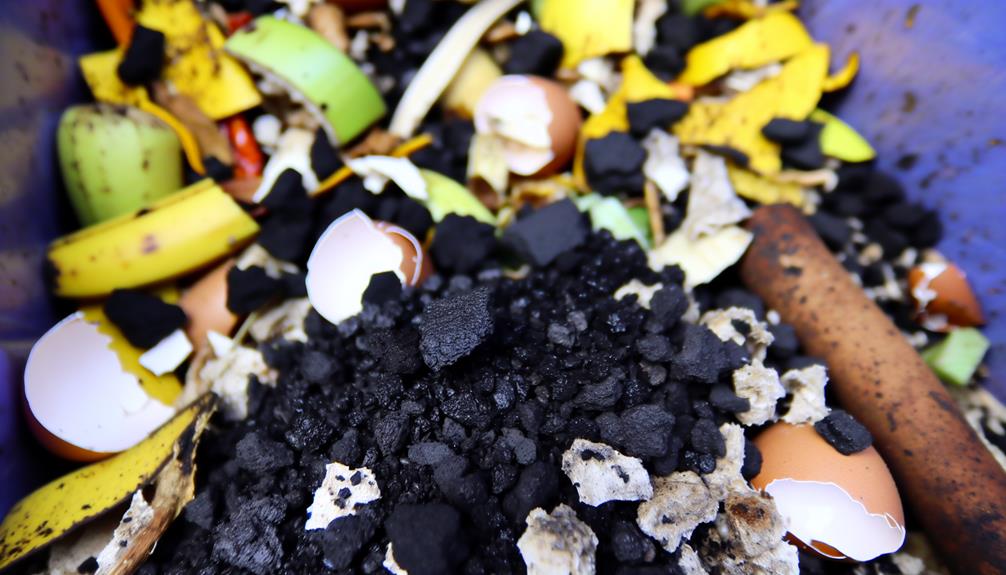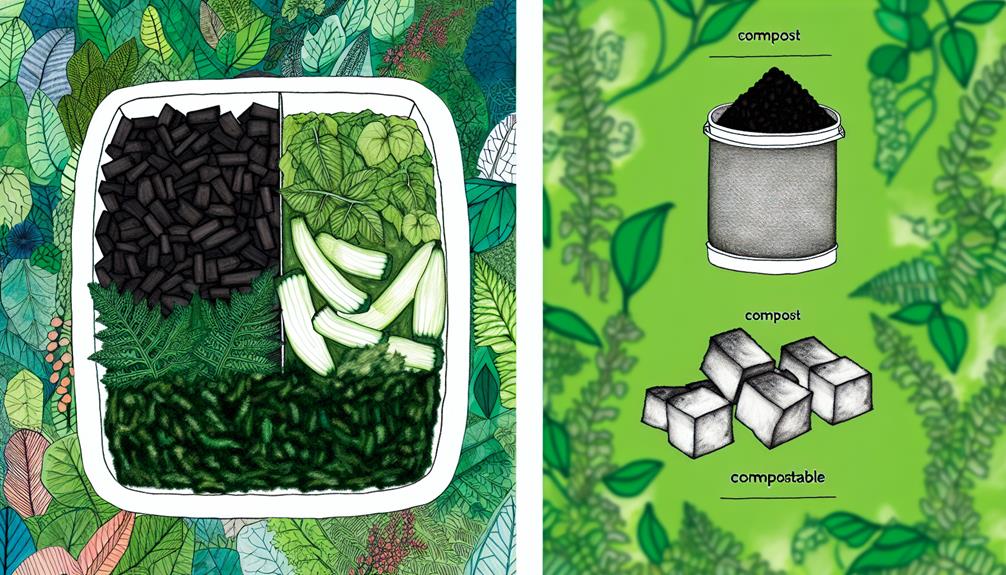

You shouldn’t compost coal. Coal contains heavy metals and pollutants that can harm soil health and plant growth. In addition, composting coal disturbs the pH balance of your compost, making it less effective. Instead, focus on composting organic waste like kitchen scraps, leaves, and grass clippings.
For improving soil structure and nutrient availability, consider using biochar, which is a safe and sustainable alternative. Always separate non-compostable items like coal from other compostable materials to keep your compost heap healthy and effective. To learn more about the best composting practices and waste management, continue with the next sections.
When learning about types of coal, you’ll want to compare anthracite and bituminous coal, each with distinct properties.
Next, it’s important to understand the unique characteristics of lignite.
Among the various types of coal, anthracite and bituminous are the most commonly discussed due to their distinct characteristics and uses. You’ll find that both types play significant roles in coal mining and coal combustion, but they’ve different properties that make them suitable for specific applications.
Anthracite is the highest grade of coal. It has a high carbon content and burns cleaner compared to other types. Because of its high energy content, it’s often used in home heating and industrial processes where intense heat is required. Anthracite is harder and denser, making it less likely to degrade during mining and handling.
On the other hand, bituminous coal is more abundant and easier to mine. It’s softer and has a lower carbon content than anthracite but produces more smoke and pollutants when burned. This type of coal is commonly used in electricity generation and as a raw material in steel production due to its higher volatile matter content, which makes combustion easier.
Understanding these differences helps you appreciate why anthracite and bituminous have specific uses and how their properties impact their applications.
Whether you’re considering energy production or industrial use, knowing the right type of coal is essential.
While anthracite and bituminous coals have their specialized uses, lignite stands out for its unique characteristics and applications. Known as ‘brown coal,’ lignite is the youngest type of coal, formed from compressed peat. Its formation process is less extensive compared to other coals, resulting in a lower carbon content and higher moisture. This makes lignite less energy-dense, but it’s abundant and easy to mine.
You’ll find lignite’s industrial uses primarily in electricity generation. Its high moisture content makes it unsuitable for long-distance transportation, but it’s perfect for local power plants. Lignite’s role in power generation is important, especially in areas where other types of coal are scarce.
Here are some key characteristics of lignite:
Understanding these traits helps you appreciate lignite’s place in the broader coal spectrum and its specific industrial applications.
Have you ever wondered why sub-bituminous coal is often chosen for industrial applications over other types of coal? This type of coal strikes a balance between energy content and moisture levels, making it a reliable choice for various industrial processes.
Sub-bituminous coal typically has higher energy content than lignite but lower than bituminous coal. Its energy content ranges from 8,300 to 11,500 British Thermal Units (BTU) per pound. This makes it efficient for electricity generation and industrial heating.
Additionally, sub-bituminous coal has moderate moisture levels, averaging between 15% and 30%. This moisture content allows it to ignite more easily and burn cleaner than lignite, reducing emissions and making it more environmentally friendly.
Here’s a quick comparison to help you understand its properties better:
| Property | Sub-bituminous Coal |
|---|---|
| Energy Content | 8,300-11,500 BTU/lb |
| Moisture Levels | 15%-30% |
| Sulfur Content | Low |
| Carbon Content | Moderate |
| Common Uses | Electricity, Heating |
Coal’s environmental impact is significant, contributing to air pollution, greenhouse gas emissions, and habitat destruction. When you consider the entire lifecycle of coal, from mining to combustion, the negative effects are apparent.
Let’s break down some of the major issues:
Understanding these impacts helps you see why reducing coal use is essential. By being informed and making eco-friendly choices, you join a community working towards a healthier planet.
Your actions, from reducing energy consumption to supporting renewable energy, can make a difference.
Shifting our focus from the challenges of coal, let’s explore how composting can offer a sustainable solution for managing organic waste. Composting transforms organic matter like food scraps and yard waste into nutrient-rich soil. This process not only reduces landfill waste but also enriches the soil, enhancing its ability to retain moisture and support plant growth.
To start composting, you’ll need a balance of green materials (like fruit peels and grass clippings) and brown materials (like dried leaves and cardboard). Layer these materials in a compost bin, ensuring proper aeration by turning the pile regularly. This helps accelerate the decomposition process and prevents unpleasant odors.
The composting benefits are numerous. By diverting organic matter from landfills, you reduce methane emissions, a potent greenhouse gas. Additionally, compost improves soil health, reduces the need for chemical fertilizers, and promotes healthy plant growth.
Also Read: Can You Compost Cauliflower Scraps?
Integrating coal into composting practices sparks a compelling debate, balancing potential benefits against significant drawbacks. While some argue that coal can add valuable minerals to your compost, the risks of coal contamination and its impact on soil health can’t be ignored.

Here’s a breakdown to help you decide:
For a healthier, more sustainable garden, it’s important to weigh these factors carefully. Opting for safer, non-toxic composting materials can help maintain robust soil health and protect the environment.
Given the drawbacks of using coal in compost, exploring safer and more effective alternatives becomes essential for maintaining a healthy garden. One excellent option is biochar usage. Biochar, a form of charcoal made from organic materials, serves as an incredible soil amendment. It improves soil structure, boosts water retention, and enhances nutrient availability – all without the harmful effects associated with coal.
To use biochar, mix it into your soil at a recommended rate of 10% by volume. This amendment won’t only benefit your plants but also help sequester carbon, making it an environmentally friendly choice. You can create biochar at home using garden waste or purchase it from garden centers.
Other soil amendments worth considering include compost made from kitchen scraps, leaves, and grass clippings. These organic materials break down naturally, enriching the soil with essential nutrients.
You might also explore using worm castings, which are known to improve soil health and plant growth significantly.
Also Read: Can You Compost Broad Beans?
Managing non-compostable waste effectively promotes a cleaner and more sustainable environment. To do this, you need to focus on waste segregation and proper recycling methods.

Here are some steps to help you manage non-compostable waste:
You shouldn’t use coal ash in gardening due to toxicity concerns. Although it has some nutrient content, the heavy metals and harmful substances can harm your plants and soil. Stick to safer, eco-friendly alternatives for your garden community.
Coal affects soil pH levels by increasing soil acidity, which can cause a nutrient imbalance. You’ll find that this disrupts plant growth, making your garden less thriving. Stick with composting organic material to maintain harmony.
You might wonder if coal is considered hazardous waste. Due to coal toxicity and the environmental impact of coal mining, many regulations classify certain coal byproducts as hazardous. It’s important to handle it responsibly within our community.
When considering safe disposal methods for coal, you should focus on coal recycling to minimize environmental impact. Join communities that prioritize sustainable practices and avoid contributing to pollution by responsibly managing coal waste.
You might wonder if any plants benefit from coal byproducts. Surprisingly, biochar benefits from coal’s industrial byproducts, enriching soil and helping plants thrive. By using biochar, you’ll join a community committed to sustainable gardening.
To sum up, you shouldn’t compost coal due to its environmental impact and non-biodegradable nature.
Instead, focus on composting organic materials like kitchen scraps, yard waste, and paper products.
For managing non-compostable waste, consider recycling or proper disposal methods.
Always research and follow local guidelines for waste management.
By making informed choices, you’ll contribute to a healthier environment and a more efficient composting process.
Remember, effective composting starts with knowing what materials are suitable.
